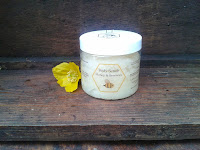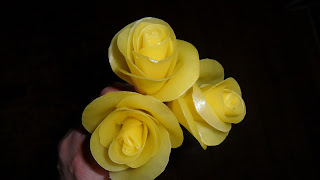One of the things I do is make candles, pure 100% beeswax candles. No other
candle wax produces as good a candle as beeswax, but over the years I've
discovered that not all beeswax candles are as good as they should be. People buying them are being conned.
Here are 5 things you should look for when buying beeswax
candles
1. Is it really all pure beeswax?
Most candles are made using blended waxes and usually contain mostly paraffin
wax. Beeswax, a natural and superior wax for candle making, is much more
expensive. If you don't see beeswax mentioned on the label, you won't have
beeswax in the candle. If it does say beeswax look a little more closely. I've
seen candles labelled as '100% pure beeswax' only to find that the candle
contains this, but only as 10% of the waxes in the candle - the rest were
paraffin waxes!
2. Has the wick been primed?
Not always easy to tell from a photograph, but obvious if you can actually
see the candle. Priming a wick isn't difficult, but it's an extra step in making
a candle and so many candle makers don't bother. As a result, their candles
don't light as easily, especially the first time. It still matters even if you
never intend to burn your candle; unprimed wick frays. So how can you tell if
the wick has been primed? A primed wick has been soaked in wax before being used
to make the candle. A wick primed for beeswax will have the colour of beeswax.
If the wick is white, it definitely hasn't been primed.
Don't forget that natural beeswax comes in a variety of shades; properly
primed wick made be a different shade to the candle it's in!
3.Has it got the right wick?
Not easy to tell by looking, but you'll get the best burn from a beeswax
candle if the wick used has been made for beeswax and not paraffin or other
waxes. The braiding to make the wick is different.
The size of wick is also important; too large and the candle will burn too
quickly; too small and the flame will be weak or molten wax will smoother the
candle and stop it burning. Candle testing is the only way to be certain the
wick is right.
4.Are the candles tested?
Testing a candle means burning it so obviously the candle you're thinking of
buying won't have been tested, but the maker should have tested candles like it.
Testing ensures the candle has the right wick, that it lights and re-lights
easily and how long the candle burns for among other things. If the candle
hasn't been tested, how do they know it's right and more importantly, how do
you?
5. How has the candle been made?
Most candles are made in moulds, but not all. They produce very good candles
with good burn times. Rolled candles burn quicker, because, no matter how
tightly they're rolled, there is some air between the layers. The longest
lasting candles are hand dipped. A skilled candle dipper can ensure there are no
air bubbles at all in their candle. This is very labour intensive and rare these days - be prepared to pay more for a candle like this.
























